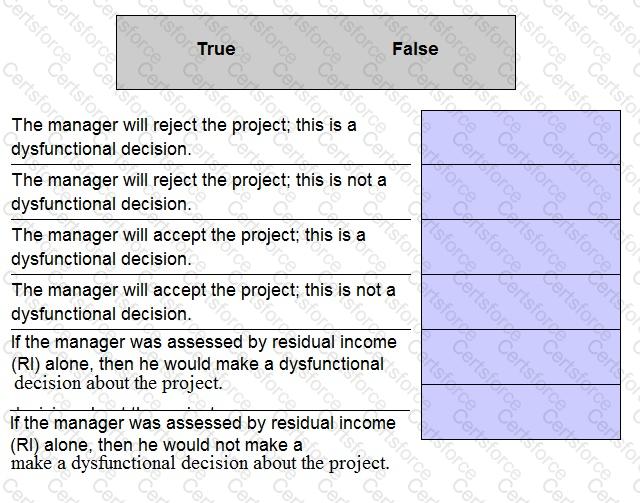A company has invested $500,000 in developing a new product and requires a return of 12% on this investment.
The company has researched the market and has set the selling price for the new product at $300 per unit. At this price, sales volume for next year is forecast to be 500 units. The forecast unit cost is $210.
What is the target cost gap per unit for the coming year?
Give your answer to the nearest whole $.
A company has a cost of capital of 12% and a maximum of $20 million to invest. It has identified three possible investment projects, none of which is divisible, as follows.

Which project(s) should the company invest in?
If transfer prices are set at variable costs, the supplying division does not cover its fixed costs.
Which of the following does NOT resolve this problem?
Risk management can be represented as a four step process. The four steps, shown randomly, are:
1. Establish appropriate risk management policies.
2. Risks are identified by key stakeholders.
3. Risks are monitored on an ongoing basis.
4. Risks are evaluated according to the likelihood of occurrence and impact on the organization.
Which of the following is the correct order for the four steps?
A company produces a single product which is sold to one customer.
Components for the product are stored in a warehouse and when required for production they are inspected. Those passing the quality check are moved to the initial production line. Part-completed items are then inspected and those passing this second quality check are moved to the warehouse until required in the finishing process. After the finishing process the products are inspected, packaged and returned to the warehouse until required by the customer.
The company is considering implementing a full just-in-time (JIT) system for both purchasing and production and has asked your advice about the activities that will be necessary if this system is implemented.
Which THREE of the following activities will definitely be required in the proposed JIT system?
In an organization's transfer pricing system the selling division and the purchasing division each record a different price for the same transaction.
This is known as a:
PorkyCo is a leading bread manufacturer in Toyland operating two functional divisions: pulled and roasted. PorkyCo uses IT systems in all of its functions, for example, accounting has one system, manufacturing has its
system, warehousing has another and human resources is the latest to develop a dedicated system to manage training and development
The issue now is that when the CEO, Mr Button, needs information about two or more functions, he has to convene the department heads to get their reports and then study each in turn. As senior management
accountant at PorkyCo, help free up Mr Button's time by suggesting the most efficient way of getting all the information he needs.
A small company currently uses an information system that was implemented several years ago and is based entirely on internal data. The company is considering replacing it with a more up to date system. It has been suggested that the new system should include the use of big data.
Which TWO of the following statements are correct?
The performance of an investment centre manager is assessed by return on investment (ROI) alone. At present, his expected ROI for next year is 15%. The manager must now decide whether to invest in a new project that is expected to yield an ROI of 14%. The cost of capital is 12%.
Indicate whether each of the following statements is true or false.

The performance report for the production manager of a company for the last month included the following.
1,000 direct labor hours were worked at a basic rate of pay of $10 per hour. 200 of these hours were worked during overtime for which a 30% overtime premium was paid. 80 of these overtime hours were to fulfill a customer order that had originally been planned for manufacture next month. The sales manager had agreed to bring forward the delivery of this order at the request of the customer. The remaining overtime hours were due to unexpected inefficiency of the workforce; this has been traced to poor supervision by a junior manager.
Material costs included the following:
$5,300 of material A. Material A is a commodity and, due to changes on the global market, the actual unit cost of this material for last month was 6% higher than had been expected
$5,250 of material B. The usage of material B last month was 5% higher than it should have been due to faulty workmanship on the production line.
What is the total value of the above costs that was controllable by the production manager?